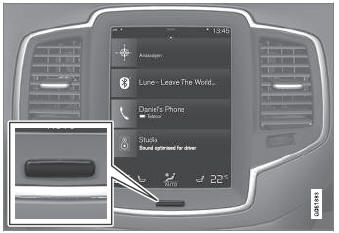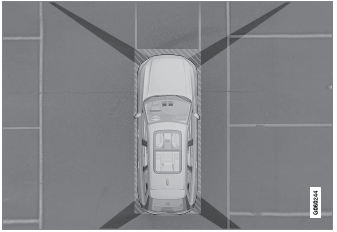Volvo XC90: Displays and voice control / Activating and deactivating the center display
The center display can be temporarily switched off and reactivated using the home button under the screen.

Center display's home button.
When the home button is used, the screen will go dark and the touchscreen no longer reacts to touch. The climate bar will remain visible. All functions connected to the screen continue to operate, such as climate, audio, guiding* and apps. The center display screen can be cleaned when the display is dimmed. The dimming function can also be used to darken the screen so it is not a distraction while driving.
- Press and hold the button beneath the screen.
- The screen will go dark (the climate bar will remain visible). All functions connected to the screen continue to operate.
- To reactivate the screen, briefly press the Home button.
- The view that was displayed before the screen was turned off will be displayed again.
NOTE
The screen cannot be turned off when a prompt to perform an action is being displayed on the screen.
NOTE
The center display is turned off automatically when the engine is off and the driver's door is opened.
* Option/accessory.
 Handling the center display
Handling the center display
Returning to Home view from another view
Briefly press the home button below the center display.
The most recent Home view mode will be displayed...
 Navigating in the center display's views
Navigating in the center display's views
There are five different basic views in the center display: Home view, Top
view, Climate view, App view and Function view. The screen is automatically activated
when the driver's door is opened...
Other information:
Volvo XC90 2015-2025 Owners Manual: IntelliSafe – driver support and safety
IntelliSafe is Volvo Cars' philosophy regarding vehicle safety. IntelliSafe consists of a number of systems1 that are designed to help make driving safer, prevent accidents and protect passengers and other road users. 1 Some of these systems are standard, while others are options...
Volvo XC90 2015-2025 Owners Manual: App menu in instrument panel
The App menu in the instrument panel provides quick access to commonly used functions for certain apps. The illustration is generic. The App menu in the instrument panel can be used instead of the center display and is then controlled using the right-side steering wheel keypad...

